Effect Modules
Modules allow you to create an effect chain. Each effect can be used only once in the module chain. You can drag modules in the module chain to rearrange them and change the processing order.
General Effect Settings
The following settings are available for each module:
- Bypass
-

Bypasses the module. This allows you to compare the sound of the unprocessed signal to that of the processed signal.
- Solo
-

Solos the module. Only one module can be soloed at a time.
- Remove
-

Removes the module from the module chain.
The following effect modules are available:
Chorus
This is a single-stage chorus effect that doubles the input signal with a slightly detuned version.
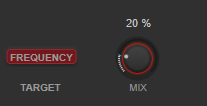
- Target
-
Shows the parameter that is modulated. Frequency changes the modulation.
- Mix
-
Sets the level balance between dry and wet signal.
Flanger
This is a classic flanger effect.
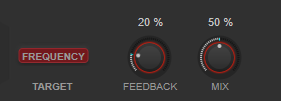
- Target
-
Shows the parameter that is modulated. Frequency changes the modulation.
- Feedback
-
Determines the character of the flanger effect. Higher settings produce a more metallic-sounding sweep.
- Mix
-
Sets the level balance between dry and wet signal.
Filter
This is a filter modulation effect. The frequency and resonance of the filter can be modulated by an LFO.

- Target
-
Selects a parameter for editing its modulation curve. Frequency changes the filter frequency. Q changes the resonance of the filter.
- Filter Type
-
Sets the filter type. Low-pass, high-pass, band-pass, and notch filters are available.
- Mix
-
Sets the level balance between dry and wet signal.
MultiMod
This is a three-stage chorus-flanger combined effect.

- Target
-
Selects a stage for editing its modulation curve.
- Feedback
-
Determines the character of the flanger effect. Higher settings produce a more metallic-sounding sweep.
- Delay
-
Affects the frequency range of the modulation sweep by adjusting the initial delay time.
- Mix
-
Sets the level balance between dry and wet signal.
Width
This effect expands or reduces the stereo width.
This effect module only works if the plug-in is applied on a stereo track.

- Target
-
Shows the parameter that is modulated. Mix changes the level balance between the dry signal and the wet signal.
- Delay
-
Increases the amount of differences between the left and right channels to further increase the stereo effect.
- Color
-
Generates additional differences between the channels to increase the stereo enhancement.
- Mono In
-
Defines the input signal as dual-mono audio.
NoteFor the stereo effect to work, you must activate this option if your input signal is a dual-mono audio file.
- Listen Mono Out
-
Sets the output to mono. This allows you to check for unwanted coloring of the sound which can occur when creating an artificial stereo image.
Pan
This is a panning effect.
This effect module only works if the plug-in is applied on a stereo track.
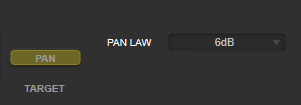
- Target
-
Shows the parameter that is modulated. Pan changes the level balance between the left and right channel.
- Pan Law
-
Sets the stereo pan law. 6 dB, 4.5 dB, 3 dB, and 0 dB determine the attenuation of the signal at the center position. Equal Power means that the power of the signal remains the same regardless of the pan setting.
Bit Crusher
This effect uses bit reduction to decimate and truncate the input audio signal to get a noisy, distorted sound.

- Target
-
Selects a parameter for editing its modulation curve. Mix changes the level balance between the dry signal and the wet signal. Sample Div. changes the amount by which the audio samples are decimated. At the highest setting, nearly all of the information describing the original audio signal is eliminated, turning the signal into unrecognizable noise.
- Bits (0 to 24 bits)
-
Defines the bit resolution. A setting of 24 gives the highest audio quality, while a setting of 1 creates mostly noise.
- Mode
-
Allows you to select one of the four operating modes. In each mode, the effect sounds differently. Modes 1 and 3 are nastier and noisier, while modes 2 and 4 are more subtle.
Overdrive
This effect creates a tube-like overdrive effect.
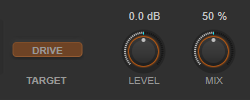
- Target
-
Shows the parameter that is modulated. Drive adds harmonics to the output signal.
- Level
-
Adjusts the output level.
- Mix
-
Sets the level balance between dry and wet signal.
Pitch Shifter
This is a pitch-shifting effect.

- Target
-
Selects a parameter for editing its modulation curve. Detune changes the pitch of the input signal in semitones. Formant changes the natural timbre of the input signal.
- Formant Preservation
-
Keeps the formants when changing the pitch with the Detune control.
- Mix
-
Sets the level balance between dry and wet signal.
Frequency Shifter
This effect shifts each frequency of the input signal by a fixed amount, which alters the harmonic relations. Adding feedback produces a sound similar to a phaser.
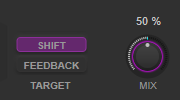
- Target
-
Selects a parameter for editing its modulation curve. Shift changes the amount of frequency shift. Feedback changes the amount of the signal that is sent from the output of the effect back to its input.
- Mix
-
Sets the level balance between dry and wet signal.
Compressor

- Target
-
Shows the parameter that is modulated. Trig. Level XXX
- Threshold (-60 to 0 dB)
-
Determines the level where the compressor kicks in. Only signal levels above the set threshold are processed.
- Ratio
-
Sets the amount of gain reduction applied to signals above the set threshold. A ratio of 3:1 means that for every 3 dB the input level increases, the output level increases by 1 dB.
- Attack (0.1 to 100 ms)
-
Determines how fast the compressor responds to signals above the set threshold. If the attack time is long, more of the early part of the signal passes through unprocessed.
- Release (10 to 1000 ms)
-
Sets the time after which the gain returns to its original level when the signal drops below the threshold.
- Make-Up (0 to 24 dB or Auto mode)
-
Compensates for output gain loss caused by compression.
Volume
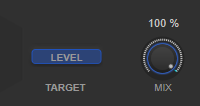
- Target
-
Shows the parameter that is modulated. Level changes the output level.
- Mix
-
Sets the level balance between dry and wet signal.
Time Shifter
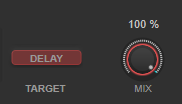
- Target
-
Shows the parameter that is modulated. Delay changes the delay time.
- Mix
-
Sets the level balance between dry and wet signal.
Reverb
This is a versatile reverb for realistic room ambience and reverb effects.

- Target
-
Shows the parameter that is modulated. Mix changes the level balance between the dry signal and the wet signal.
- Pre-Delay
-
Determines how much time passes before the reverb is applied. This allows you to simulate larger rooms by increasing the time it takes for the first reflections to reach the listener.
- Time
-
Allows you to set the reverb time in seconds.
- Size
-
Alters the delay times of the early reflections to simulate larger or smaller spaces.